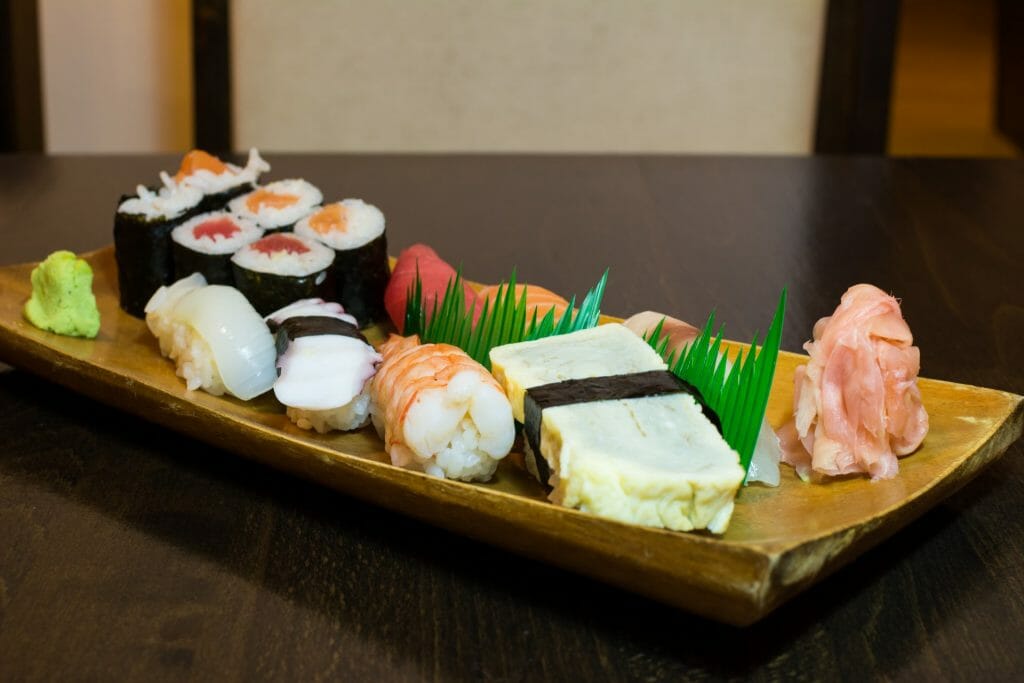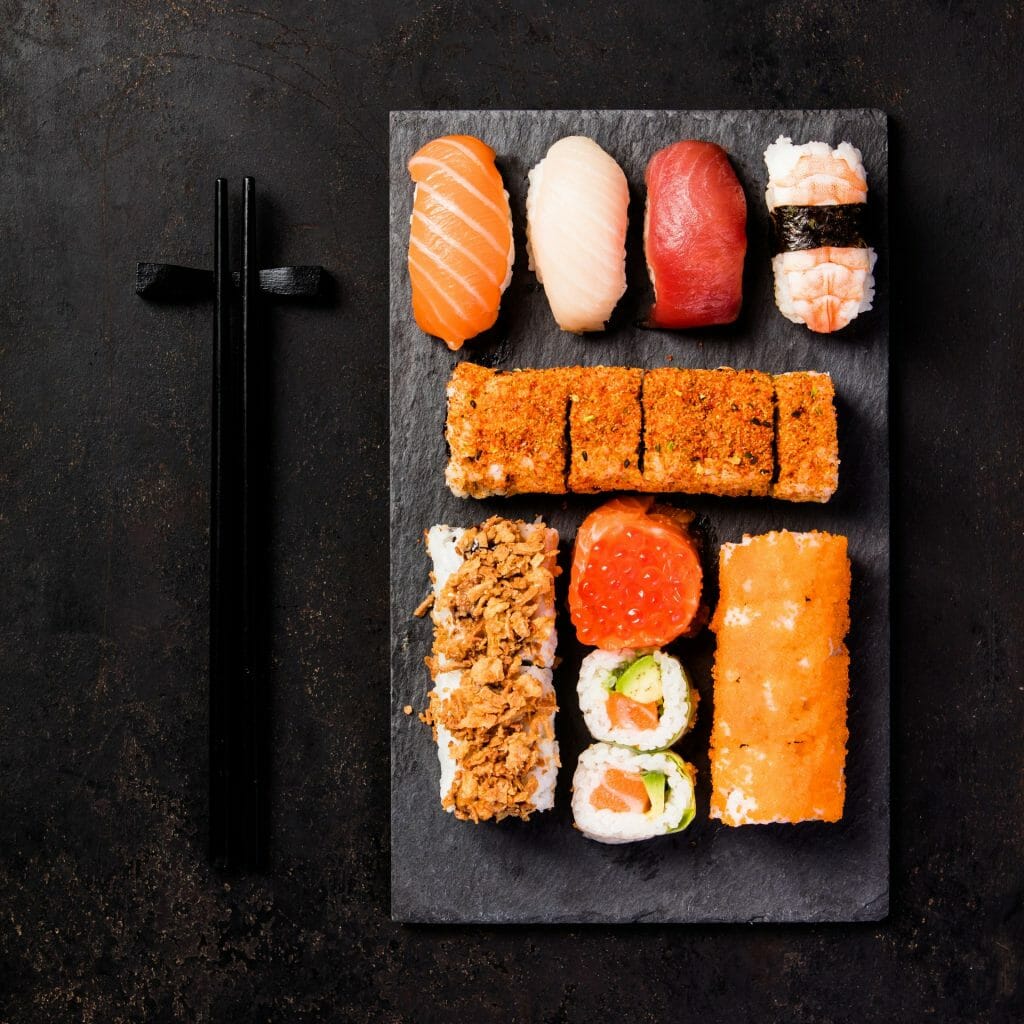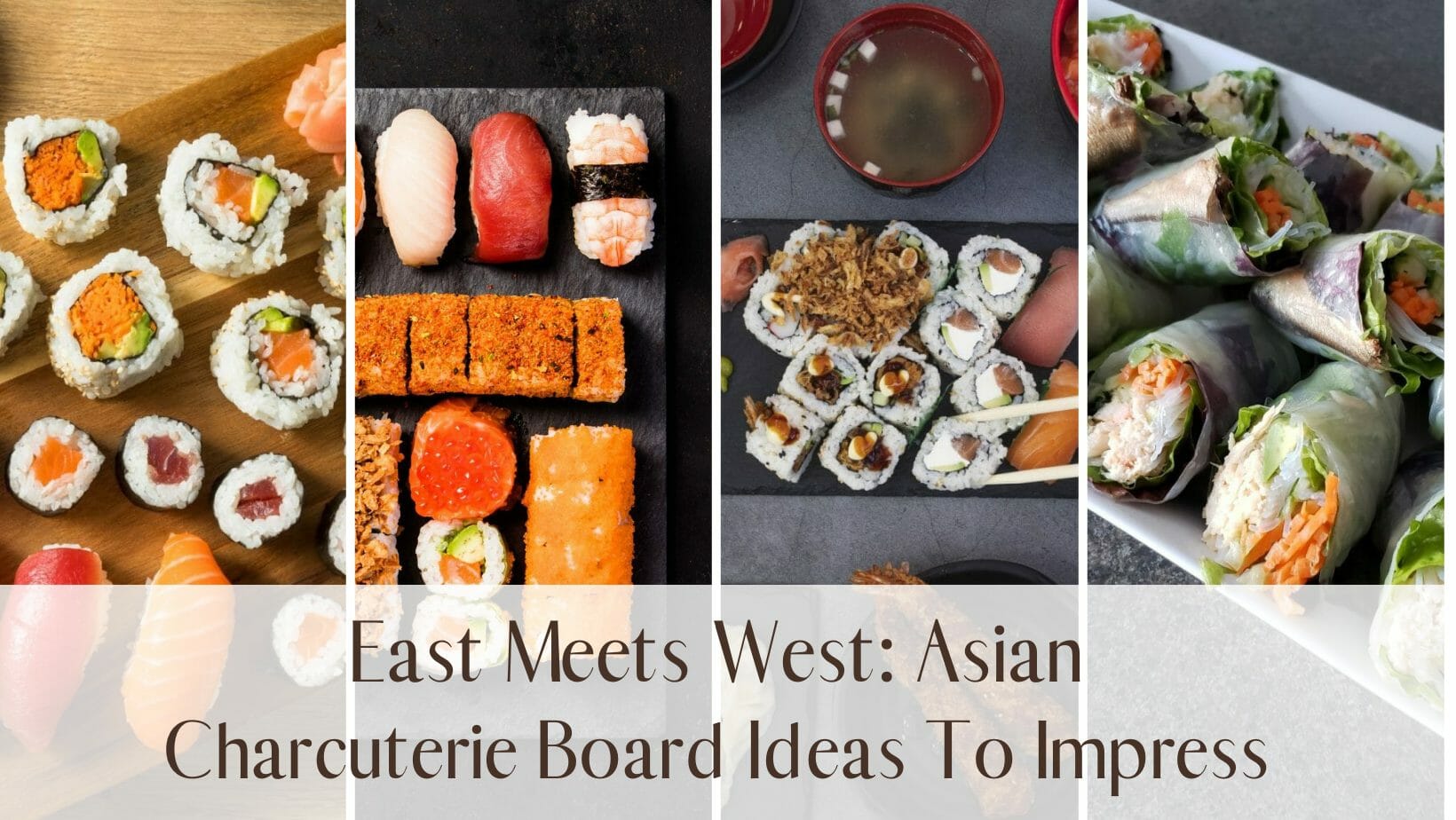Are you a fan of charcuterie boards? Do you love trying new flavour combinations and exploring different cultures through food? If so, you're in for a treat! In this article, we're going to explore the world of Asian charcuterie boards, a delicious and visually stunning way to showcase the flavours and textures of Asian cuisine. From savoury meats and cheeses to sweet fruits and desserts, we'll show you how to create a stunning and flavourful spread that will impress your guests and satisfy your cravings. Whether you're a seasoned charcuterie board pro or a curious beginner, you'll find plenty of inspiration and tips to take your next Asian-themed gathering to the next level. So let's dive in and discover the art of Asian charcuterie!
TIP: Dive into charcuterie mastery with immediate access to a community of 514K professionals. Click here and start transforming your gatherings today!
Table of Contents [CLICK HERE TO OPEN]
- How to Create an Amazing Asian Charcuterie Board: Tips and Ideas
- What is an Asian Charcuterie Board?
- Selecting the Right Ingredients
- How to Arrange Your Board
- Drinks and Pairings
- Trends and Innovations in Asian Charcuterie Boards
- Hints and Tips for an Extra Special Asian Charcuterie Board
- Inspiration
- Wrapping It Up
- Frequently Asked Questions
How to Create an Amazing Asian Charcuterie Board: Tips and Ideas
The concept of an Asian charcuterie board has been gaining popularity in the culinary world as a fun and creative way to showcase a variety of Asian-inspired foods. Whether you're hosting a party or just looking for a fun snack, an Asian charcuterie board offers a visually stunning display of delicious bites that are sure to impress your guests.
In this article, we'll provide you with inspiration and guidance on creating your own Asian charcuterie board. We'll discuss the importance of selecting high-quality ingredients and arranging them in an aesthetically pleasing manner. From savory meats and cheeses to sweet fruits and candies, we'll show you how to mix and match flavors and textures to create a board that's both delicious and visually stunning.
So, whether you're a seasoned foodie or just looking to impress your guests, keep reading to learn how to create the perfect Asian charcuterie board.

What is an Asian Charcuterie Board?
An Asian charcuterie board is a creative twist on the classic meat and cheese platter that incorporates a range of Asian-inspired ingredients. It's a perfect way to showcase the rich and diverse flavors of Asian cuisine while also impressing guests with a unique presentation. What sets an Asian charcuterie board apart is its focus on fresh, raw, and pickled ingredients rather than cured meats and cheeses.
Typical ingredients that you might find on an Asian charcuterie board include sushi rolls, sashimi, dumplings, edamame, pickled vegetables, seaweed salad, and sliced fruits. These ingredients offer a range of flavors, from sweet and tangy to savory and umami. Some popular condiments include soy sauce, wasabi, pickled ginger, and sriracha.
The key to a successful Asian charcuterie board is to balance the flavors and textures of the different components. For example, the crispness of fresh vegetables can be paired with the creaminess of avocado, while the heat of spicy tuna rolls can be balanced by the sweetness of mango. Incorporating a variety of colors and shapes can also enhance the visual appeal of the board. With a little creativity and some high-quality ingredients, you can create a stunning Asian charcuterie board that will impress your guests and satisfy their taste buds.

Selecting the Right Ingredients
When creating an Asian charcuterie board, it's crucial to choose the right ingredients to ensure that the flavors are authentic and delicious. Selecting fresh and flavorful ingredients is key, as the success of the board depends on the quality of the foods used.
Sushi and Sashimi
Sushi and sashimi are both excellent additions to an Asian charcuterie board. Some popular sushi options to include are salmon, tuna, eel, and shrimp. When selecting sashimi, look for options like tuna, salmon, and yellowtail. These ingredients are sure to impress guests with their authentic flavors and textures. It's important to choose ingredients that are fresh and of high quality to ensure that they taste great. When selecting sushi and sashimi, be sure to choose the freshest fish available to ensure that they taste their best. Look for fish that has a bright, shiny color and a firm texture.
Other Asian Foods
To add variety to the board, consider including other Asian foods such as dumplings, pickled vegetables, and edamame. These foods offer different textures and flavors and can be paired with a variety of sauces and dips. For other Asian foods, such as dumplings and spring rolls, consider using homemade versions or buying them from a reputable Asian market.
Consider The Aesthetic
When selecting ingredients, it's important to consider the overall aesthetic of the board as well. Choosing foods with different colors and textures can create a visually appealing and exciting spread. Don't be afraid to get creative and experiment with different combinations to create a unique and memorable charcuterie board.
Textures and Flavors
One of the key elements of an Asian charcuterie board is the variety of textures and flavors. Be sure to include a mix of crispy, chewy, and crunchy items, such as crispy shrimp chips, chewy rice cakes, and crunchy pickled vegetables. It's also important to include a variety of flavors, such as salty, sweet, spicy, and sour, to keep the board interesting and balanced. Consider including items such as soy sauce, wasabi, and pickled ginger to add extra flavor to the board.
Dietary Restrictions
Another important factor to consider when selecting ingredients is dietary restrictions. If you're serving guests with dietary restrictions, be sure to include a variety of options that are suitable for their needs. For example, you might include vegetarian sushi rolls, gluten-free dumplings, or low-sodium options. This will ensure that everyone can enjoy the board and feel included in the experience.

How to Arrange Your Board
When it comes to creating an Asian charcuterie board, the presentation is just as important as the quality of the ingredients. A well-arranged board can enhance the overall experience and make it more enjoyable for your guests. Here are some tips on how to arrange your board:
Start with the largest items first: Begin by placing the larger items, such as sushi rolls or bowls of noodles, in the center of the board. This will act as the focal point and help guide the eye towards the other ingredients.
Mix and match colors: It's important to consider the colors of the ingredients when arranging the board. Aim for a variety of colors to create a visually appealing display. For example, place bright orange salmon sashimi next to green edamame or purple pickled cabbage.
Use different textures: Incorporating different textures is essential to keep the board interesting. Consider adding crispy shrimp chips, chewy rice cakes, and crunchy vegetables to create a dynamic and exciting eating experience.
Play with height: Varying the height of the ingredients can help create visual interest. Use small bowls or ramekins to elevate certain items, such as wasabi or soy sauce, and stack smaller items like dumplings or meat skewers.
Leave some empty space: Don't feel the need to fill every inch of the board. Leaving some empty space can help the ingredients stand out and make the board feel less cluttered.
By considering color, texture, and shape when arranging the ingredients, you can create a beautiful and inviting Asian charcuterie board that is sure to impress your guests.
Drinks and Pairings
No charcuterie board is complete without the perfect drink to accompany it. For an Asian charcuterie board, there are several options that can perfectly complement the flavors and textures of the ingredients.
Sake: One popular option is sake, a traditional Japanese rice wine that pairs well with sushi and sashimi. Sake has a unique flavor profile that ranges from sweet to dry, making it versatile enough to pair with a variety of dishes on the board.
Green Tea: Another great pairing option is green tea, which can help cleanse the palate between bites and enhance the flavors of the food. The subtle earthy notes in green tea can also complement the savory umami flavors of the board.
Wine: For those who prefer wine, a light and crisp white wine, such as a Pinot Grigio or Sauvignon Blanc, can also work well with an Asian charcuterie board. These wines have a refreshing acidity that can help balance out the richness of some of the ingredients on the board.
When selecting drinks and pairings, it's important to consider the overall flavor profile of the board and choose options that can enhance and complement those flavors. A well-paired drink can take your Asian charcuterie board to the next level and create a truly memorable culinary experience.

Trends and Innovations in Asian Charcuterie Boards
Asian charcuterie boards have been growing in popularity over the years, and with that growth comes new trends and innovations.
Unique Vessels
One trend that has been making waves is the use of unique vessels to hold the ingredients. Instead of the traditional wooden board, people are getting creative with the presentation of their boards, using items such as bento boxes, bamboo steamers, or even serving trays made from stone or slate. These unique vessels can add an extra layer of visual appeal to the board and make for a more interesting presentation.
Exotic Ingredients
Another trend is the incorporation of new and exotic ingredients. While traditional Asian charcuterie boards usually include sushi, sashimi, and dumplings, people are now experimenting with new and exciting ingredients such as Korean fried chicken, Japanese curry, and even Chinese hot pot ingredients like thinly sliced beef and seafood. These ingredients offer new flavors and textures that can elevate the board to the next level.
Eco-Friendliness
In addition to the new ingredients, there has also been a focus on incorporating sustainability and eco-friendliness into the boards. This can be seen in the use of reusable or biodegradable plates and utensils, or sourcing ingredients from local and sustainable sources. This shift towards sustainability not only benefits the environment but also adds a layer of consciousness to the overall experience.
Overall, these trends and innovations in the Asian charcuterie board world allow for more creativity and experimentation, making the experience of creating and enjoying a board even more exciting. By incorporating unique vessels, new and exotic ingredients, and sustainable practices, the possibilities are endless for creating a truly memorable and enjoyable experience for all.

Hints and Tips for an Extra Special Asian Charcuterie Board
Creating an Asian charcuterie board is already a unique and exciting experience, but there are some tips and tricks you can use to make it even more special. Here are a few ideas:
Add some homemade touches: Consider making your own pickled vegetables or dumplings to add a personal touch to your board. You could also make your own sushi rolls or add a homemade dipping sauce.
Use unique vessels: Consider using unique vessels to hold your ingredients. For example, you could use small bamboo steamers to hold dumplings, or use a hollowed-out pineapple to hold fruit.
Play with color and texture: Consider the color and texture of the ingredients you are using and try to create a visually appealing board. For example, you could use green lettuce leaves as a base and then layer colorful sushi rolls on top. Add a variety of textures by including items with different levels of crunch, such as crispy shrimp chips or crunchy pickled vegetables.
Get creative with presentation: Use unique platters or cutting boards to create a visually appealing presentation. Consider arranging items in a circular pattern, or layering items to create depth and dimension.
Consider the season: Take advantage of seasonal ingredients and flavors to add a unique touch to your board. For example, in the summer you could add fresh watermelon or mango, or in the fall you could include roasted pumpkin or butternut squash.
By following these tips, you can create an Asian charcuterie board that is truly unique and special. Remember to have fun and experiment with different flavors, textures, and presentation techniques to create a board that is as delicious as it is beautiful.
Inspiration
Looking for some inspiration for your next Asian charcuterie board creation? Look no further than Instagram, where food bloggers and enthusiasts have been sharing their stunning and creative charcuterie boards. From colorful arrangements to unique ingredients, Instagram is a treasure trove of ideas to elevate your board to the next level. In this section, we'll showcase some of the most inspiring and drool-worthy Asian charcuterie boards on Instagram. Get ready to be inspired and take your charcuterie game to the next level!
Wrapping It Up
In conclusion, creating an Asian charcuterie board is a fantastic way to enjoy the flavors and textures of Asian cuisine in a fun and creative way. Whether you are a seasoned pro or a beginner, with the right ingredients, arrangement, and pairings, you can create an impressive and visually stunning board that will wow your guests.
So, why not give it a try? Gather your favorite ingredients, some drinks and pairings, and start arranging your board today. With a little creativity and experimentation, you can create a culinary masterpiece that is sure to impress.
We hope this article has inspired you to try creating your own amazing Asian charcuterie board. Enjoy the process, have fun, and don't be afraid to let your creativity shine!
Frequently Asked Questions
What is the Asian version of a charcuterie board?
The Asian version of a charcuterie board is a platter or board that showcases a variety of Asian-inspired meats, cheeses, fruits, vegetables, and condiments. It may feature items such as sushi, sashimi, pickled vegetables, dried or cured meats, nuts, and exotic fruits. The presentation and arrangement of the items may also incorporate traditional Asian aesthetics, such as bento boxes, bamboo serving trays, or intricate carving and plating techniques. Overall, the Asian charcuterie board offers a unique and flavourful twist on the classic charcuterie board, allowing for a diverse range of tastes and textures to be enjoyed in a visually appealing way.
What cheese goes with Asian food?
Some cheeses that go well with Asian food are goat cheese, feta, ricotta, and cream cheese. However, it ultimately depends on the specific dish and flavors you're working with. Experimenting with different cheeses can lead to new and delicious flavor combinations.
What do you put on an Asian charcuterie board?
An Asian charcuterie board typically includes a variety of cured meats, such as Chinese lap cheong or Japanese shiokara, along with Asian-inspired cheeses, crackers, fresh and dried fruits, nuts, pickles, and condiments such as soy sauce or wasabi. Other items that can be added include sushi, sashimi, dumplings, and Asian-style spreads such as edamame hummus or miso butter. The key is to mix and match flavors and textures to create a balanced and visually appealing display.
Share Your Creations:
We’d love to see the charcuterie boards you create using our guide! Feel free to share your own creations in the comments or on social media, and tag us for a chance to be featured. And if you have any other ideas or tips for creating the perfect charcuterie board, we’d love to hear them.







